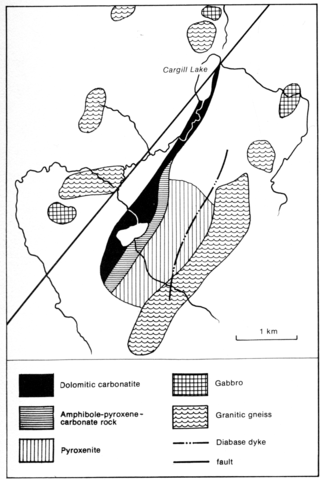stripes
This complex is intruded into Precambrian granite gneisses and quartz gabbros. Outcrop is scarce but there is a strong, double aeromagnetic anomaly. There is a variety of ultramafic rocks, many showing layering, and including olivine and hornblende pyroxenite and hornblendite, all with variable Ti-magnetite and abundant sphene. These are cut by late segregation veins rich in aegirine. Carbonatites cut the ultramafic rocks. In the western part they form a plug-like body and comprise calcite and dolomitic carbonatites with apatite, richterite to arfvedsonite, phlogopite, olivine and titaniferous clinohumite. Pyrochlore has not been reported. The eastern part has apatite- dolomite carbonatite. There has been deep erosion, probably by karst development and collapse, producing an extensive depression about 200 m deep, which is filled with lacustrine sediments overlying a residual layer rich in apatite. Pollen as old as Cretaceous has been identified in the sediments.
BENNETT, G., BROWN, D.D., GEORGE, P.T. and LEAHY, E.J. 1967. Operation Kapuskasing. Miscellaneous Paper, Ontario Department of Mines, 10: 1-98.
J. Gittins, personal communication, 1984.
GITTINS, J., MACINTYRE, R.M. and YORK, D. 1967. The ages of carbonatite complexes in eastern Canada. Canadian Journal of Earth Sciences, 4: 651-5.

